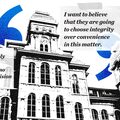‘Corpórea’ exhibition seeks to take adult participants’ minds off ‘autopilot’

Individual handmade portraits hang in La Casita Cultural Center's art gallery. The artworks, made by participants of a six-week art therapy program at the center, use color and collage in introspection. Nathaniel Harnedy | Contributing Photographer
Get the latest Syracuse news delivered right to your inbox.
Subscribe to our newsletter here.
Think about what your body is doing right now. Loosen your jaw and let your tongue fall from the roof of your mouth. Relax your shoulders and neck.
This check-in is one of many somatic therapy techniques Bennie Guzman, program coordinator at La Casita Cultural Center, taught in his art therapy program, helping them turn off emotional “autopilot.”
“We’re wired to know how to survive,” Guzman said. “(But) we forget about our emotions. We lose track of what our body is telling us sometimes. Somatic therapy is about re-establishing that connection.”
Guzman, a graduate student studying art therapy at Syracuse University’s College of Visual and Performing Arts, guided a cohort of 20 participants through a six-week art therapy program this summer. Those six weeks culminated in “Corpórea,” an exhibition that opened on Friday.
The program’s participants, consisting of La Casita staff members and Syracuse locals, contributed to four body maps and multiple individual portraits. They are on display at La Casita’s gallery through April. The recent six-week program was Guzman’s master’s degree thesis.
Instead of creating a traditional portrait, Guzman asked participants to use color and collage techniques to explore how they physically encounter emotions each day. Guzman said to him, Corpórea (which translates to “corporeal” in English) means examining what it means to connect with and hold power in your body.
The process of creating the pieces helped participants explore their identities and emotions, Guzman said. The benefits of the art therapy program didn’t just come from the process of making the art, but also the conversations that grew from it, he said.
As they created the art pieces, participants shared personal stories about losing family members and pets, or immigrating to the United States, Guzman said. These stories opened up discussion about how to hold space for grief, support each other during loss and find hope during hardship. Guzman said he was amazed by how quickly participants felt comfortable sharing difficult stories.
“It’s not easy for any people to talk about, when they’re struggling, the kind of trouble they face, let alone in this community where, in Latino stories traditionally, we’re told not to express our emotions,” Guzman said. “We’re told to just kind of keep your head down and keep moving forward.”
Guzman’s personal experience using art to process stress and depression drives his interest in art therapy. While an undergraduate student at Colgate University, he remembered coming together with friends to share art, giving him an understanding of the widespread benefits of art therapy.
Guzman said most of the participants in the six-week program didn’t have prior art experience, so he introduced the concept as art making rather than art therapy. As people became more engaged with making art, he said they began to realize the therapeutic benefits, enjoying the time to relax and decompress.

Participants of Bennie Guzman’s “Art as Mindfulness” art therapy program created four communal body maps. The pieces are meant to explore emotions and identities deeper than what’s possible in a traditional portrait. Nathaniel Harnedy | Contributing Photographer
Ana Arango, La Casita’s community engagement coordinator, was one of the people who hadn’t expressed themselves through art before. The experience allowed her to relax, and made it easier for her to do her job and connect with the community, she said.
Arango created one of the individual portraits and added touches to the body maps. Her piece portrays colorful butterflies and flowers pouring out of a jar, representing her outlook on her life.
“The flowers, I tried to make different colors, because when I see the light every morning, when I wake up, I wake for a new day and open for new experience,” Arango said.
Seeing her art hanging on the wall made Arango feel proud and grateful. The program was exciting for her; she learned new skills every day, she said.
The artists collaborated to explore different techniques and materials, creating a fun environment and ensuring that no two pieces were exactly alike, Guzman said.
“There’s a kind of freedom in the fact that I wasn’t looking for perfect art,” Guzman said. “There’s a freedom in not caring about the technique. I just want you to express what you’re feeling and have fun with it.”
Paola Méndez Soto, the exhibition’s curator and a recent VPA graduate in museum studies, said the process of making and installing the art was healing for her and the community at La Casita.
Soto has a background in historical exhibitions in the past, and working on a current, community-led project was a brand new experience for her. She said she enjoyed understanding the reasons why each artist created what they did, and even got to add to the body maps herself.
The artists worked on each piece on tables or floor space. Soto said finding a way to mount the large fabric hangings onto the wall without distracting from the art’s content was difficult, but a worthy adventure.
Guzman said he doesn’t feel like the community needs him to continue their art therapy journey. It’s important to him that he makes enough of a long term contribution that people can continue creative practices on their own. He hopes people take away at least one technique that helps them reconnect with their bodies, whether they have half an hour or five minutes.
“It was less about giving something, and more about uncovering something that was already there and giving them a voice or a language to use those things more effectively,” Guzman said.
As Soto listened to the artist’s reactions to seeing their work installed, she saw a significant emotional response, with lots of “happy tears.” She said some of the artists who participated were told as children that they could never be artists.
“When they started the art therapy program, they would say ‘Oh, I’m not an artist,’” Soto said. “And now, once they see the art pieces on the wall, they say, ‘This is amazing. I never thought I could do something like this.’”






